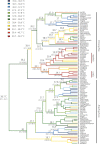Upper thermal limits of Drosophila are linked to species distributions and strongly constrained phylogenetically
- PMID: 22988106
- PMCID: PMC3479592
- DOI: 10.1073/pnas.1207553109
Upper thermal limits of Drosophila are linked to species distributions and strongly constrained phylogenetically
Abstract
Upper thermal limits vary less than lower limits among related species of terrestrial ectotherms. This pattern may reflect weak or uniform selection on upper limits, or alternatively tight evolutionary constraints. We investigated this issue in 94 Drosophila species from diverse climates and reared in a common environment to control for plastic effects that may confound species comparisons. We found substantial variation in upper thermal limits among species, negatively correlated with annual precipitation at the central point of their distribution and also with the interaction between precipitation and maximum temperature, showing that heat resistance is an important determinant of Drosophila species distributions. Species from hot and relatively dry regions had higher resistance, whereas resistance was uncorrelated with temperature in wetter regions. Using a suite of analyses we showed that phylogenetic signal in heat resistance reflects phylogenetic inertia rather than common selection pressures. Current species distributions are therefore more likely to reflect environmental sorting of lineages rather than local adaptation. Similar to previous studies, thermal safety margins were small at low latitudes, with safety margins smallest for species occupying both humid and dry tropical environments. Thus, species from a range of environments are likely to be at risk owing to climate change. Together these findings suggest that this group of insects is unlikely to buffer global change effects through marked evolutionary changes, highlighting the importance of facilitating range shifts for maintaining biodiversity.
Conflict of interest statement
The authors declare no conflict of interest.
Figures


References
-
- Intergovernmental Panel on Climate Change . Climate Change 2007: Synthesis Report. Geneva: Intergovernmental Panel on Climate Change; 2007. p. 52.
-
- Thomas CD, et al. Extinction risk from climate change. Nature. 2004;427:145–148. - PubMed
-
- Kimura MT. Cold and heat tolerance of drosophilid flies with reference to their latitudinal distributions. Oecologia. 2004;140:442–449. - PubMed
-
- Hoffmann AA, Sorensen JG, Loeschcke V. Adaptation of Drosophila to temperature extremes: Bringing together quantitative and molecular approaches. J Therm Biol. 2003;28:175–216.
Publication types
MeSH terms
LinkOut - more resources
Full Text Sources
Molecular Biology Databases

